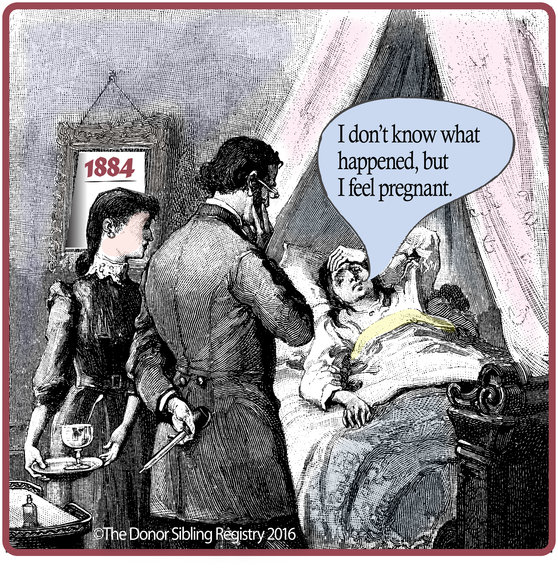偃月橫照大地 劃戟直刺青天
信則有
人工授精 AI 成功導致一個嬰兒誕生並成長
發生在1884年, 美國費城。這是人類曆史上的第一次(競管幹的甚為荒唐)
英國,美國,蘇聯等國的醫科學家 為先驅。
成為一項比較成功的技術 發生於 1970年末期
大約10年之後,才開始比較更廣泛。
中國醫學界 采用此技術 比較晚, 到了1980年代後期。
生於 1970年的 毛新宇 不可能是 人工授精的嬰兒
更不可能是 試管嬰兒的孩子。
寫此文的目的有二
1,簡介人工授精的簡史
2,批駁那些低劣編造的讕言 詆毀 汙蔑 毛岸英先生及其兒子毛新宇出生的無恥謊言
鐵的事實, 不容扭曲。
造謠 1970年1月17日出生的毛新宇 是 人工授精而生產的, 可以休矣!
以後造謠 要多下功夫, 造出水平,也許可以 以假亂真,否則, 空惹 貽笑大方!
Artificial Insemination In Humans
1,The first recorded experiment with artificial insemination in humans occurred in 1799, when Scottish-born surgeon John Hunter impregnated a women with her husband’s sperm, resulting in a successful pregnancy.
2,In 1884 American physician William Pancoast performed a modified artificial insemination procedure when he injected sperm from a donor into a woman who was under anesthesia. The woman, who was married, gave birth to a baby nine months later and did not know that she had been impregnated with donor sperm. Her husband, whom Pancoast determined was infertile, later found out about the procedure from Pancoast.
https://www.britannica.com/science/artificial-insemination?
3,The first physician to take a systematic approach to human artificial insemination was the controversial 19th-century surgeon J. Marion Sims of North Carolina. Although he founded the Women’s Hospital in New York, the first establishment devoted solely to women’s health, he’s also known for more troubling activities: Many of his notable medial contributions were a result of research he conducted on slaves without his subjects’ consent. The Women’s Hospital opened in 1855, and during its first several years in operation, Sims performed 55 artificial-insemination procedures on six different women; only one resulted in a pregnancy, and it ended in a miscarriage.
4,the first artificial insemination to result in a live birth, performed by the Philadelphia physician William Pancoast, of the Jefferson Medical College in Philadelphia,didn’t happen until a few decades after Sims’ attempts. In 1884, one of Pancoast’s patients, a 31-year-old woman, came to see him at Sansom Street Hospital about her inability to conceive. her husband’s low sperm count. Her husband, a 41-year-old wealthy merchant from Philadelphia.
https://www.theatlantic.com/health/archive/2016/01/first-artificial-insemination/423198/

This unnamed woman delivered a healthy baby boy nine months later. Presumably, all were ecstatic. The only problem was that Dr. Pancoast never actually informed her about what he did to her on the table that fateful day. Whether it was to spare her the embarrassment of her husband’s sterility, or whether it was simply to see if he could do it at all, Dr. Pancoast’s experiment remained a secret success for 25 years.
It was only after Dr. Pancoast died — a quarter-century after the successful insemination of his presumably pleased patient — that the truth became known. In 1909, one of the students present that day, the suggestively named and incredibly handsome Dr. Addison Davis Hard, fessed up and published a letter in the journal Medical World containing all the dirty details. It is interesting to note that Dr. Pancoast did actually inform the woman’s husband of what he had done, and that they had decided together to spare her the truth. In addition, before the letter was published, Dr. Hard took it upon himself to tell the by-then all-grown-up baby boy as well. Hopefully, his mother was not a subscriber of Medical World in her old age.
1979
Of 711 physicians likely to perform artificial insemination by donor surveyed to determine their current practices, 471 responded, of whom 379 reported that they performed this procedure. They accounted for approximately 3576 births by this means in 1977. In addition to treating infertility, 26 per cent of these physicians used the procedure to prevent transmission of a genetic disease, and 10 per cent used if for single women. Donors of semen were primarily from universities, were only superficially screened for genetic diseases, and were then matched phenotypically to the recipient’s husband. Most recipients were inseminated twice per cycle. Only 17 per cent of physicians used the same donor for a given recipient, and 32 per cent used multiple donors within a single cycle. Only 37 percent kept records on children, and only 30 per cent on donors. The identity of donors usually was carefully guarded to ensure privacy and to avoid legal complications.
1987
The Office of Technology Assessment made visits to 3 sperm banks and 10 in vitro fertilization clinics.
A total of 1,558 questionnaires were completed and returned by the sampled physicians (a response rate of 61 percent), which included 37 physicians in the cross-sectional sample and 385 fertility society physicians regularly doing artificial insemination, i.e., seeing four or more insemination patients per year. An amended survey form was also sent to 30 U.S. commercial sperm banks identified by the American Association of Tissue Banks (MTB) and the American Fertility Society (AFS), and 15 of those forms were returned. The survey estimates that 172,000 women underwent artificial insemination in 1986-87, at an average cost of $953, resulting in 35,000 births from artificial insemination by husband (AIH), and 30,000 births from artificial insemination by donor (AID).
http://www.huffingtonpost.com/wendy-kramer/a-brief-history-of-donor-conception_b_9814184.html
In the 1980s, direct intraperitoneal insemination (DIPI) was occasionally used, where doctors injected sperm into the lower abdomen through a surgical hole or incision, with the intention of letting them find the oocyte at the ovary or after entering the genital tract through the ostium of the fallopian tube.
https://en.wikipedia.org/wiki/Artificial_insemination
人工授精 與 試管嬰兒 不同。
試管嬰兒
1978年7月25日,全世界第一位試管嬰兒路易絲·布朗在英國誕生。First baby born from IVF (Louise Brown, in England).
1981: First IVF baby born in the United States (Elizabeth Jordan Carr).
1988年3月10日北京醫科大學第三附屬醫院誕生出中國大陸第一位試管嬰兒。




